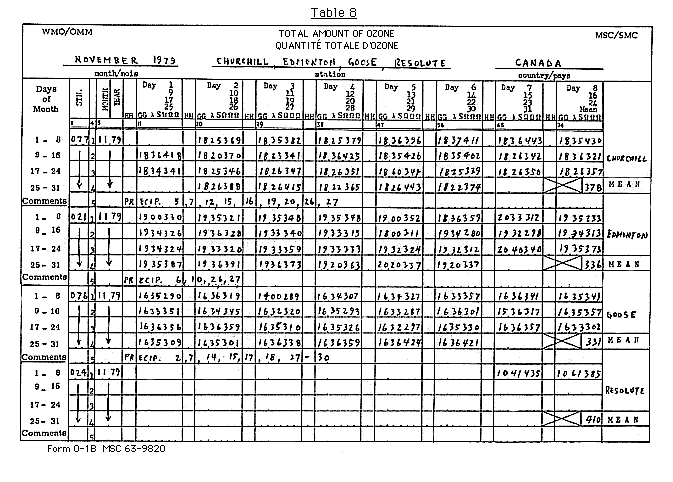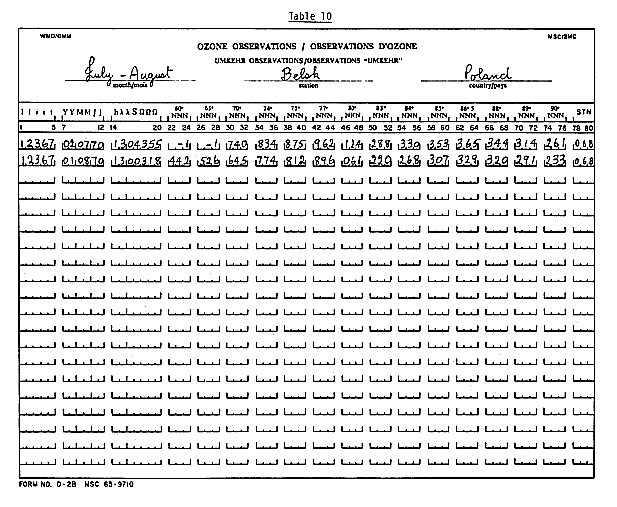Coding and Archiving Ozone Data
Canada collects and publishes ozone data on a worldwide basis under sponsorship of the World Meteorological Organization. Data collection and publication arrangements are described in Guide Book No. 2 (1980), which is available free from the Canadian Atmospheric Environment Service to meteorological services and research organizations which have a reciprocal arrangement with the Atmospheric Environment Service for exchange of publications (automatically including all groups that supply ozone data and all those that regularly subscribe to the issues of "Ozone Data for the World"). Individual copies of the Guide Book are available to other organizations and individuals for 25 cents payable to the Receiver General of Canada.
Ozone data should be forwarded to Canada for publication on a bi-monthly basis as soon as possible after the end of February, April, June, August, October, and December, respectively. The mailing address is
World Ozone Data Centre
Atmospheric Environment Service
4905 Dufferin Street
Downview, Ontario
Canada M3H5T4
The frequency of publication of the data depends on the clarity of the entries on the data sheets transmitted and the promptness with which these data sheets are supplied.
8.1 Coding Total Ozone Data for Publication
Total ozone data should be coded on WMO/OMM Form O-1B according to instructions provided in Guide Book No. 2 which are reproduced in Table 7 of this manual. Table 8, also reproduced from the Guide Book, shows a completed sample Form 0-1B.
| Table 7 TOTAL AMOUNT OF OZONE, INSTRUCTIONS FOR COMPLETING FORM 0-1B |
|
| The term 'column'
refers to any space from 1-80 across the data form; the term 'line' refers
to the lines down the sheet which are numbered in column 4 from 1 - 5.
One month's Total Ozone observations required 5 lines to complete. Observations are entered across the page from the 1st of the month (Day 1), until the 31st of the month (Day 31).
9 - 16 are on line 2 17 - 24 are on line 3 25 - 31 are on line 4.
Any remarks should be entered briefly on line 5. Explanation of columns: Columns 1 - 3 to be left blank; to be coded by our data processing centre to identify the station. Column 4 is always preprinted, and identifies lines 1 - 5. Columns 5 - 6 two-figure entry for the month of observation (01 = January) Columns 7 - 8 two-figure entry for the year of observation (1969 = 69) Columns 9 - 10 HH, hour G.M.T. of beginning of observation period. Not to be used by stations who use columns 11-12 (GG) to indicate the number of observations, or the hour of observation. Columns 11 - 12 GG, hour G.M.T. of observation, or the number of observations which were averaged to obtain the value for total ozone. Some stations indicate the period during which observations were averaged to obtain the value for total ozone.(Example: 01-06 indicates observations were made between the hours 01 and 06. In this case, HH is coded 01, and GG is coded 06.) Columns 13 - 17 WSOOO as coded previously on form 0-1A. Remaining columns are coded HHGGWSOOO
|
Explanation of lines:
Line 1 Code the month and the year. and then HHGGWSOOO for days 1 to 8 Line 2 Code the month and the year, and then HHGGWSOOO for days 9 to 16 Line 3 Code the month and the year, and then HHGGWSOOO for days 17 to 24 Line 4 Code the month and the year, and then HHGGWSOOO for the 25th of the month up to the end of the month, and the mean total ozone for the month in columns 78, 79, and 80. Line 5 If there are any comments or remarks to he made, code the month and the year, and then write the remarks in capital letters starting in column 9. Columns 9-80 may be used. If there are no remarks, do not make any entries on line 5. General notes (1) where data for a particular day are missing, do not make an entry for HHGGWSOOO. See sample of completed entry form; * Instructions for coding are also given in Table 9 (see coding of columns 15 - 20 of WMO Form 0-2B). See Guide Book 2 for more information. |
8.2 Coding Umkehr Data for Processing and Publication
Umkehr data should be coded on WMO/OMM Form 0-2B according to instructions provided in Guide Book No. 2 which are reproduced in Table 9 of this manual. Table 10, also reproduced from the Guide Book, shows a completed sample Form 0-2B.
| Table 9 UMKEHR OBSERVATIONS, INSTRUCTIONS FOR COMPLETING FORM 0-2B |
|
|
1- 5 IIiii - WMO Index Number of Station 7- 8 YY - Greenwich day of month (01-31)* 9-10 MM - Greenwich month (01-12)* 11-12 JJ - Greenwich year (1965 coded 65)* 14 h - Observation time, before local apparent noon afternoon = 2 15 W - Wavelength used, A coded 1, B = 2, C = 3, D = 4 16 W - Wavelength used for total ozone observation (see code 1) 17 S - Kind of total ozone observation (see code 2) 18-20 OOO - Total ozone in milli atmo-centimetres. (m atm-cm), (Formerly 10-3 STP cm) 22-24 NNN - (Log I'/I + constant) for zenith angle of the sun in column heading (see note "B") 26-76 NNN - Complete as for columns 22-24 78-80 Please leave blank
The "column" number refers to the column number across Form 0-2B.
The Greenwich day of the month for Umkehr observations is the day, Greenwich time, upon which local noon falls.
NNN (Log I'd + constant) to three decimal places for the zenith angle of the sun indicated in the column heading. When (Log I'/I + |
constant) exceeds unity, leave out the
integer; example, when (Log I'/I + constant) = 1.031, NNN is coded 031.
When an observation is missing, enter as follows:
1 On direct moon 2 On blue zenith sky 3 On zenith cloud (uniform stratified layer of small opacity) 4 On zenith cloud (uniform, or moderately variable layer of med. opacity) 5 On zenith cloud (uniform, or moderately variable layer of large opacity) 6 On zenith cloud (Highly variable layer, with or without precipitation) 7 On zenith cloud (Fog) 8 Other (specify) 9 " " |
Return to Table of Contents
Forward to References
Forward to Acknowledgements
Forward to Appendix A. Determination of Q Setting Tables for Standard Wavelengths

